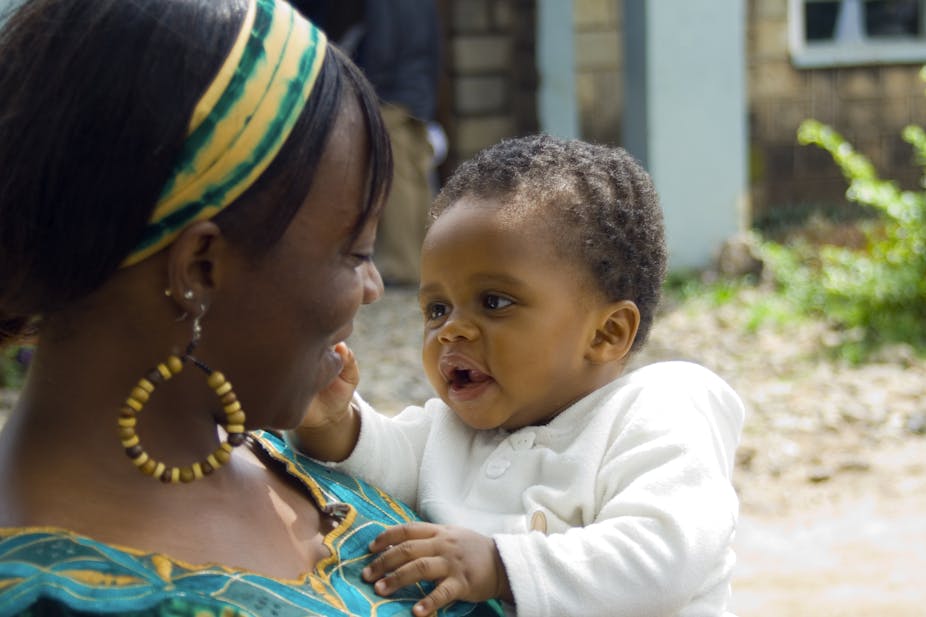The prevention of HIV from mothers to children has been the most successful HIV prevention programme in South Africa and across the globe.
When the programme was started in 2002, transmission of HIV from mothers to children was as high as 40%. Estimates are that the current transmission rate when women stop breastfeeding is around 5% and about 2% of children exposed to HIV are infected by the time they reach six weeks old.
Despite these tremendous gains, certain areas need attention to reduce the burden of paediatric HIV. Around 360 000 children under 14 years live with HIV in South Africa. Of these children only 50% access anti-retroviral treatment.
The gaps in the programmes relate to mothers, babies, children and teenagers and explain the remaining challenges with South Africa’s HIV prevention strategy around children.
Delayed treatment for mothers
There are three main problems around mothers:
pregnant women are booked into anti-retroviral programmes late,
new mothers drop off these programmes, and
misconceptions around exclusive breastfeeding.
Considering the success of prevention of mother to child transmission programmes, nearly all HIV-infected pregnant women should be initiated onto anti-retroviral treatment. But in 2013/4, only 81% of those needing treatment accessed it.
Many women access HIV testing at their first antenatal care visit. But those who become HIV-infected during their pregnancy must be diagnosed with a retest later. This test is not always repeated.
For HIV-infected women not yet diagnosed or on anti-retrovirals, each week without prophylaxis increases the risk of infecting the baby, particularly if the woman is newly infected and has a high viral load. They are more likely to transmit HIV to their babies in-utero, during delivery or through breastfeeding.
After birth, new mothers drop off the anti-retroviral treatment, attending fewer clinic visits. Some struggle to maintain clinic visits on return to work. Others believe they don’t need treatment when they stop breastfeeding. The South African government’s guidelines recommend lifelong anti-retroviral treatment for all women starting in pregnancy or during breastfeeding.
Lastly, there are lingering misconceptions around breastfeeding. Several studies show when both mother and baby are on anti-retrovirals in the first few weeks after birth, the benefits of breastfeeding far outweigh the risks of HIV transmission. Some parents and healthcare workers are still concerned about the HIV risk in breastfeeding infants.
Getting babies early treatment
South Africa has excellent HIV testing guidelines for HIV-exposed babies. In babies who get prolonged nevirapine prophylaxis, a viral test to detect viral material, rather than a rapid HIV test, is done at birth and then again at 10 and 16 week clinic visits. A final antibody test - the rapid HIV test - is done at 18 months. A final test is done six weeks after breastfeeding stops, or if the infant is symptomatic.
We argue that the an extra HIV test should be done at the nine month measles immunisation visit, which is well attended. If an HIV rapid screening test was done here and the baby tested positive a viral test would be done, replacing the post-feeding viral test which is usually poorly done as there is no fixed time for it.
This would mean babies are diagnosed with HIV before they are one. The first 12 months are known to be the highest risk period for mortality and morbidity if anti-retrovirals are not started.
Traditionally, HIV treatment for children under one has had to be doctor initiated. This needs to change so that HIV-infected children are diagnosed by nurses and given treatment before they fall ill. This is especially true for children from rural and under-resourced areas where doctors specialising in paediatric HIV are not readily available.
Targeting HIV in childhood
In the past few years, HIV testing guidelines have been substantially tightened for children under 18 months old. At the beginning of the epidemic, these testing guidelines were less rigorous and testing was frequently aimed at sick children.
But some children only become obviously ill late in childhood or in early to mid-teens. Often these youngsters have low CD4 counts and are very ill when they get help. This is precious time that’s being wasted. Several programmes address this including the Paediatric Adolescent Scale-up Programme. It aims to increase testing in children and teenagers and access to anti-retroviral treatment, ensuring quality care.
Infants and children require a lifetime of anti-retroviral treatment. Our goal should be for them to have the same life expectancy as their uninfected peers. To achieve this, their treatment regimens must be carefully managed. There should be an emphasis on excellent adherence, a simple regimen and as few side effects as possible.
The special challenge of adolescence
HIV-infected teenagers are considered a high-risk group because they fail to adhere to their treatment programmes. It can take time for an immunological or clinical deterioration to become apparent. These feelings of wellness are often the reason they abandon treatment.
Adherence difficulties are also driven by clinical, emotional and social factors that teenagers experience. These are exacerbated by the HIV infection because issues of sexuality and social exploration become more complex.
Poor adherence to treatment results in an increase in their viral load. They also become resistant to treatment.
Children growing up with HIV and newly infected teenagers need additional support. A youth friendly approach is needed to deal with issues that affect adherence. This includes:
access to sexual and reproductive health care,
mental healthcare screening and treatment,
exploration of violence and orphanhood, and
social and financial difficulties.
The end goal is for these HIV infected teens to transition to adult care with good clinical and mental health outcomes.

